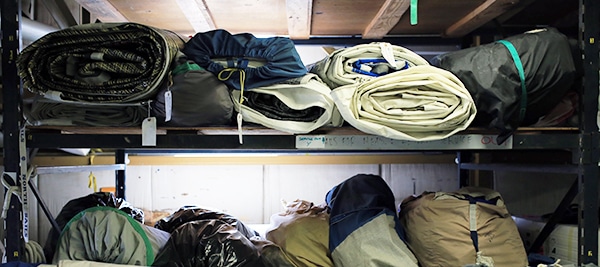
Fall is a beautiful time of year, but for many the change in colors signals the end of the sailing season. Many owners take great care in making sure their boats are properly “winterized” and stored, but their sails are not always given the same care.
When you’re ready to store your boat for the winter, make sure you take care of your sails too. There are three main factors to consider when planning what to do with or where to store your sails at the end of the sailing season.
- What is the general condition of your sails?
- Are there any modifications you’d like to make?
- Where will you store your sails?
Sail Condition
Off season is the time to get your sails checked and maintained so they’re ready to go in the spring. A large percentage of repairs that we see during the sailing season can be avoided by a thorough winter check and service.
Dirt, stains, and salt are not only unsightly, they can shorten the life of your sail. Grit and salt crystals can – and will – chafe fibers in the sail cloth. This damage is small and slow acting, but it can add up over time and make a difference in how long a sail lasts.
Salt also attracts moisture. Moisture and warm temperatures lead to mildew. Mildew won’t necessarily shorten the life of your sail, but who wants to unroll their genoa and see a Jackson Pollack?

Sail Modifications
Are you considering adding an extra reef to your mainsail? Maybe some full-length battens? Planning on converting from hank on headsails to roller furling, or upgrading to a new system? Do any of your sails need a spreader or radar dome chafe patch? These sail modifications are best performed during the off season. That will allow us to work on your sail without cutting into your time on the water.
Sail Storage
Sails need to be stored where they are safe from moisture, temperature extremes, and pests. Any combination of these can ruin a good sail.
As I said earlier, moisture increases the risk of mildew and stains. Temperature extremes can also potentially damage laminates. High temperatures can even cause woven sails to change shape or become brittle.
When it comes to pests, mice and rats love rolled up sails – they provide a secure environment, ample material that can be shredded for bedding, and a good supply of salt. This can leave you with a sail full of holes and littered with feces and urine stains, which are not only hard to get out, but also unhealthy to humans.
Insects and spiders also like to nest in sails. They don’t do as much damage as rodents, but it’s still not pleasant to open your sail bag at the beginning of the season and find these multi-legged tenants.
The best way to store your sails is to hang them from the ceiling so they don’t touch anything. The next best option is to store them on a shelf (keep the open end of the bag facing away from any walls for better air circulation and to make it harder for a pest to get in). If you want to make sure that rodents stay away, an ultrasonic noise system will do the job nicely.
Whether you’re storing your sails at home or at a loft, be sure to follow these steps to make sure your sails are ready to go when you are next spring.
–David Simmons
This cruising tip has been brought to you by Quantum Sails.








